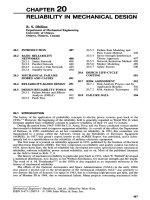LGA775 SOCKET MECHANICAL DESIGN GUIDE ppt
Bạn đang xem bản rút gọn của tài liệu. Xem và tải ngay bản đầy đủ của tài liệu tại đây (640.42 KB, 25 trang )
LGA775 Socket
Mechanical Design Guide
February 2006
Document Number: 302666-003
INFORMATION IN THIS DOCUMENT IS PROVIDED IN CONNECTION WITH INTEL® PRODUCTS. NO LICENSE, EXPRESS OR IMPLIED, BY
ESTOPPEL OR OTHERWISE, TO ANY INTELLECTUAL PROPERTY RIGHTS IS GRANTED BY THIS DOCUMENT. EXCEPT AS PROVIDED IN
INTEL’S TERMS AND CONDITIONS OF SALE FOR SUCH PRODUCTS, INTEL ASSUMES NO LIABILITY WHATSOEVER, AND INTEL
DISCLAIMS ANY EXPRESS OR IMPLIED WARRANTY, RELATING TO SALE AND/OR USE OF INTEL PRODUCTS INCLUDING LIABILITY OR
WARRANTIES RELATING TO FITNESS FOR A PARTICULAR PURPOSE, MERCHANTABILITY, OR INFRINGEMENT OF ANY PATENT,
COPYRIGHT OR OTHER INTELLECTUAL PROPERTY RIGHT. Intel products are not intended for use in medical, life saving, or life sustaining
applications.
Intel may make changes to specifications and product descriptions at any time, without notice.
Designers must not rely on the absence or characteristics of any features or instructions marked "reserved" or "undefined." Intel reserves these for
future definition and shall have no responsibility whatsoever for conflicts or incompatibilities arising from future changes to them.
The Intel® Pentium® 4 processor and Intel® Pentium® D processor may contain design defects or errors known as errata which may cause the
product to deviate from published specifications. Current characterized errata are available on request.
Contact your local Intel sales office or your distributor to obtain the latest specifications and before placing your product order.
Intel, Pentium, and the Intel logo are trademarks or registered trademarks of Intel Corporation or its subsidiaries in the United States and other
countries.
*Other names and brands may be claimed as the property of others.
Copyright © 2004–2006, Intel Corporation
2
Mechanical Design Guide
Contents
1
Introduction ......................................................................................................................... 7
1.1
1.2
1.3
Document Goals and Scope .................................................................................. 7
1.1.1
LGA775 Socket Overview....................................................................... 7
1.1.2
Document Goals ..................................................................................... 7
1.1.3
Important Remarks ................................................................................. 7
Terminology............................................................................................................ 8
Reference Documents............................................................................................ 8
2
Assembled Component and Package Description ............................................................. 9
3
Mechanical Requirements ................................................................................................ 11
3.1
3.2
3.3
3.4
3.5
3.6
Attachment ........................................................................................................... 11
Socket Components ............................................................................................. 12
3.2.1
Socket Body.......................................................................................... 12
3.2.1.1
Housing ............................................................................... 12
3.2.1.2
Package Installation / Removal Access .............................. 12
3.2.1.3
Socket Standoffs ................................................................. 12
3.2.1.4
Markings .............................................................................. 13
3.2.1.4.1
Name ................................................................... 13
3.2.1.4.2
Lot Traceability .................................................... 13
3.2.1.5
Contacts .............................................................................. 13
3.2.1.6
Solder Balls ......................................................................... 14
3.2.2
Socket Actuation Mechanism ............................................................... 14
3.2.3
Pick and Place Cover ........................................................................... 14
3.2.4
Socket Insertion / Actuation Forces...................................................... 15
Socket Size........................................................................................................... 15
Socket Weight ...................................................................................................... 15
Socket Maximum Temperature ............................................................................ 15
Manufacturing with LGA775 Socket..................................................................... 16
4
Electrical Requirements .................................................................................................... 17
5
Environmental Requirements............................................................................................ 19
5.1
5.2
Solvent Resistance............................................................................................... 20
Durability............................................................................................................... 20
Appendix A
Mechanical Drawings........................................................................................................ 21
Appendix B
Vendor Information............................................................................................................ 25
Mechanical Design Guide
3
Figures
Figure 1. Flowchart of Knowledge-Based Reliability Evaluation Methodology................. 19
Figure 2. LGA775 Socket Assembly Drawing................................................................... 22
Figure 3. LGA775 Socket Motherboard Footprint – 1....................................................... 23
Figure 4. LGA775 Socket Motherboard Footprint – 2....................................................... 24
Tables
Table 1. LGA775 Socket Electrical Requirements ........................................................... 17
Table 2. Use Conditions Environment .............................................................................. 20
Table 3. LGA775 Socket Vendors .................................................................................... 25
§
4
Mechanical Design Guide
Revision History
Revision
Number.
Description
Revision Date
-001
Initial public release
June 2004
-002
Lead-free information added
May 2005
-003
Added Vendor Information for LF sockets
February 2006
§
Mechanical Design Guide
5
6
Mechanical Design Guide
Introduction
1
Introduction
1.1
Document Goals and Scope
1.1.1
LGA775 Socket Overview
This document describes a surface mount, LGA (Land Grid Array) socket intended for
performance and value desktop platforms based on future Intel microprocessors in the 775-land
LGA package. The socket provides I/O, power and ground contacts. The socket contains 775
contacts arrayed about a cavity in the center of the socket with eutectic solder balls for surface
mounting with the motherboard. The LF-LGA775 socket contains lead-free solder balls while the
LGA775 socket contains eutectic solder balls. This design guide refers to the socket as LGA775
for simplicity, but its contents are applicable to both solder materials unless otherwise specified.
The socket contacts have 1.09 mm X 1.17 mm pitch (X by Y) in a 33x30 grid array with 15x14
grid depopulation in the center of the array and selective depopulation for alignment keys. A
matching LGA package will be mated with the socket.
1.1.2
Document Goals
The goals of this document are:
To provide LGA775 socket information necessary for motherboard design to ensure the
specified performance of the platform.
To define the boundary conditions and design constraints within which the socket design
must fit and perform.
1.1.3
Important Remarks
All LGA775 socket characteristics mentioned in this document may change.
LGA775 socket validation reports are available from socket vendors.
Mechanical Design Guide
7
Introduction
1.2
Terminology
Term
Description
LGA775 Socket
LGA775-Land
LGA Package
Processors in the 775-Land LGA package uses Flip-Chip Land Grid Array package
technology and consists in a processor core mounted on a substrate with an integrated
heat spreader (IHS). This packaging technology employs a 1.09 mm x 1.17 mm pitch for
the substrate lands. Refer to the processor datasheet for additional information.
IHS (Integrated
Heat Spreader)
1.3
Processor in the 775-land package mates with the system board through a surface
mount, 775-pin, LGA (land grid array) socket.
A component of the processor package used to enhance the thermal performance of the
package. Component thermal solutions interface with the processor at the IHS surface.
Reference Documents
Document
Comment
/>ocessor/index.htm
Processor Datasheet
Note 1
/>ocessor/index.htm
Processor Thermal Design Guidelines
Note 2
Note 3
LGA775 Socket Validation Report
®
®
Boxed Intel Pentium 4 Processor in the 775-Land LGA Package Integration Video
NOTES:
1.
2.
3.
/>n
Select the appropriate processor and then go to the technical documents tab and locate the
Processor Datasheet in the Datasheets section of the page.
Select the appropriate processor and then go to the technical documents tab and locate the
Processor Thermal Design Guidelines in the Design Guides section of the page.
Socket validation reports are available from socket vendors.
§
8
Mechanical Design Guide
Assembled Component and Package Description
2
Assembled Component and
Package Description
The LGA775 Socket dimensions and characteristics must be compatible with that of the processor
package and related assembly components. The 775-land LGA package uses Flip-Chip Land Grid
Array package technology. Processors in the 775-land LGA package are targeted to be used with
the LGA775 socket.
The assembled component may consist of a cooling solution (heatsink, fan, clips, and retention
mechanism), and processor package. The processor Thermal Design Guidelines provides
information for designing components compliant with the Intel reference design.
Relevant processor 775-land LGA package and land information is given in the processor
datasheet.
§
Mechanical Design Guide
9
Assembled Component and Package Description
10
Mechanical Design Guide
Mechanical Requirements
3
Mechanical Requirements
3.1
Attachment
The socket will be tested against the mechanical shock and vibration requirements listed in
Chapter 5 under the expected use conditions with a heatsink and retention mechanism attached
under the loading conditions outlined in the processor datasheet. The socket will only be attached
by the 775 contact solder balls to the motherboard. There are no additional external methods
(i.e., screw, extra solder, adhesive, etc.) to attach the socket.
All relevant package mechanical load specifications are given in the processor datasheet.
Important Note: Heatsink Clip Preload
Heatsink clip preload is traditionally used for:
Mechanical performance in mechanical shock and vibration.
Thermal Interface Material (TIM) performance.
Required preload depends on selected thermal interface material.
In addition to mechanical performance in shock and vibration and TIM performance, LGA775
socket requires a minimum heatsink preload to protect against fatigue failure of socket solder
joints.
Solder ball tensile stress is created by inserting a processor into the socket and actuating the
LGA775 socket load plate. In addition, solder joint shear stress is caused by coefficient of thermal
expansion (CTE) mismatch induced shear loading. The solder joint compressive axial force
induced by the heatsink preload helps to reduce the combined joint tensile and shear stress.
Overall, the heatsink required preload is the minimum preload needed to meet all of the above
requirements: Mechanical shock and vibration, TIM performance, and LGA775 socket protection
against fatigue failure.
Refer to the processor Thermal Design Guidelines for detailed information for heatsink clip static
preload and motherboard deflection guidelines for the LGA775 socket to ensure socket solder
joint protection against fatigue in temperature cycling.
Mechanical Design Guide
11
Mechanical Requirements
3.2
Socket Components
The socket is made of four main components: socket body, load plate, load lever, and socket body
stiffener (refer to Appendix A, Figure 2).
The socket will be delivered as a single integral assembly.
3.2.1
Socket Body
3.2.1.1
Housing
The housing material must be a thermoplastic or equivalent, UL 94 V-0 flame rating, temperature
rating and design capable of maintaining structural integrity following a temperature of 260 °C
for 40 seconds which is typical of a reflow/rework profile for the solder used on the socket. The
material must have a thermal coefficient of expansion in the XY plane capable of passing
reliability tests rated for an expected high operating temperature, mounted on FR4-type
motherboard material. The creep properties of the material must be such that the mechanical
integrity of the socket is maintained for the use condition outlined in Chapter 5.
The color of the socket housing must be dark, as compared to the solder balls, to provide the
contrast needed for surface-mount (SMT) equipment pick and place vision systems. Components
of the socket may be different colors as long as they meet the above requirement.
3.2.1.2
Package Installation / Removal Access
Access is provided to facilitate the manual insertion and removal of the package.
To assist in package alignment and proper orientation during package installation into the socket:
The package substrate has keying notches along two opposing edges of the package and
offset from the package centerline (refer to the processor datasheet for further details).
The socket uses two features designed to mate with the keying notches along the inside walls
of the package seating cavity (refer to Appendix A).
3.2.1.3
Socket Standoffs
Standoffs must be provided on the bottom of the socket base to ensure the minimum socket height
after solder reflow. The standoff locations and surface area are located as specified in Appendix
A, Figure 3. A minimum gap between the solder ball seating plane and the standoff prior to
reflow is required to prevent solder ball to motherboard land open joints.
12
Mechanical Design Guide
Mechanical Requirements
3.2.1.4
Markings
All markings withstand a temperature of 260 °C for 40 seconds, which is typical of a
reflow/rework profile for solder material used on the socket, as well as any environmental test
procedure outlined in Chapter 5 without degrading.
3.2.1.4.1
Name
LF-LGA775 (Font type is Helvetica Bold – minimum 6 point (or 2.125 mm)).
Note: This mark shall be stamped or laser marked into the sidewall of the stiffener plate on the actuation
lever side when lead-free solder are is used.
LGA775
(Font type is Helvetica Bold – minimum 6 point (or 2.125 mm)).
Note: This mark shall be stamped or laser marked into the sidewall of the stiffener plate on the actuation
lever side when eutectic solder balls are used.
Manufacturer’s insignia (font size at supplier’s discretion).
This mark will be molded or laser marked into the socket housing.
Both socket name and manufacturer’s insignia must be visible when first seated on the
motherboard.
3.2.1.4.2
Lot Traceability
Each socket must be marked with a lot identification code to allow traceability of all components,
date of manufacture (year and week), and assembly location. The mark must be placed on a
surface that is visible when mounted on the motherboard.
3.2.1.5
Contacts
The socket has a total of 775 contacts; with 1.09 mm X 1.17 mm pitch (X by Y) in a 33x30 grid
array with 15x14 grid depopulation in the center of the array and selective depopulation for
alignment features.
Base material for the contacts is a high strength copper alloy.
For the area on the socket contacts where processor lands will mate, there is a 0.381 m
[15 inches] minimum gold plating over 1.27 m [50 inches] minimum nickel underplate.
No contamination by solder in the contact area is allowed during solder reflow.
Mechanical Design Guide
13
Mechanical Requirements
3.2.1.6
Solder Balls
A total of 775 solder balls corresponding to the contacts are on the bottom of the socket for
surface mounting with the motherboard.
Two versions of the socket, leaded and lead-free will be available, with the following materials
for the solder balls:
Eutectic Solder
Sn63 Pb37 (+/-0.5% Sn).
Socket marking will be LGA775 for sockets comprised of eutectic solder.
Lead-free Solder
Composition must be lead free and have a melting point temperature in the range of 217220°C (for example: Sn Ag 3.0 Cu 0.5).
Socket marking will be LF-LGA775 for sockets comprised of lead-free solder.
The co-planarity (profile) requirement for all solder balls on the underside of the socket is defined
in Appendix A.
The solder ball pattern has a true position requirement with respect to applicable datum’s in order
to mate with the motherboard land pattern. Refer to Appendix A.
3.2.2
Socket Actuation Mechanism
The socket actuation mechanism is made of the load plate and the load lever. These components
are made of stainless steel SUS 301. Both components need to be fully actuated to ensure
electrical contact. When correctly actuated, the top surface of the processor IHS is above the load
plate allowing proper installation of a heatsink. The post-actuated seating plane of the package is
flush with the seating plane of the socket. Movement will be along the Z direction, perpendicular
to the motherboard.
When combined with the socket body and load lever, the load plate distributes the force necessary
to achieve the required resistance values. The load from the load plate is distributed across two
sides of the package onto a step on each side of the IHS. It is then distributed by the package
across all of the contacts.
The stiffener plate provides the interface to the load lever and the load plate and creates the
primary stiffening element to react to the load generated by the load plate.
3.2.3
Pick and Place Cover
The pick and place cover is a dual purpose removable component of the LGA775 socket. The
cover’s primary purpose is to provide a planar surface at least 20-mm in diameter and compatible
with SMT placement systems. As such, the cover retention must be sufficient to support the
socket weight during lifting, translation, and placement. The cover material should be chosen
such that it is able to withstand 260 °C for 40 seconds.
The secondary function of the Pick and Place Cover is to provide a physical barrier against
contamination and un-desirable physical contact of the socket contact array during post-SMT
handling environments in board assembly environments, shipping, and in system assembly
14
Mechanical Design Guide
Mechanical Requirements
environments. As such, cover retention is sufficient for the cover to remain in place through these
environments. The cover should be able to be installed and removed without the use of tools.
There should be no surfaces or features above the pick surface. The Pick and Place cap should
attach to the exterior of the Load Plate to maximize its distance from the socket contacts and be
compatible with volumetric keep-ins as defined in the processor Thermal Design Guidelines. The
cover should not have features that protrude below the Load Plate inner profile and into the
socket cavity. Also, there should be no features that protrude above the pick and place surface.
Further, any vent holes added to the Pick and Place Cover to aid in air circulation during reflow
should be positioned to not allow fluid contaminants a direct path to the contacts (i.e., no socket
contacts should be visible with the cover installed). Finally, a Pin 1 indicator, typically a
triangular cutout, on the Pick and Place cover is highly desirable.
3.2.4
Socket Insertion / Actuation Forces
Any actuation should meet or exceed SEMI S8-95 Safety Guidelines for Ergonomics/Human
Factors Engineering of Semiconductor Manufacturing Equipment, example Table R2-7
(Maximum Grip Forces).
The load lever actuation force must not exceed 3.9 kgf [8.6 lbf] in the vertical direction and 1 kgf
[2.3 lbf] in the lateral direction.
The pick and place cover insertion and removal force must not exceed 1 kgf [2.3 lbf].
The socket is designed such that it requires no force to insert the package into the socket.
3.3
Socket Size
Socket information needed for motherboard design is provided in Appendix A, Figure 3.
This information should be used in conjunction with the reference motherboard keep-out
drawings provided in the processor Thermal Design Guidelines to ensure compatibility with the
reference thermal mechanical components.
3.4
Socket Weight
The LGA775 socket weighs about 35 g.
3.5
Socket Maximum Temperature
The power dissipated within the socket is a function of the current at the pin level and the
effective pin resistance. The key temperature targets for the LGA775 socket are:
Temperature of socket contact < 100 °C sustained.
Temperature of socket solder ball < 91 °C sustained.
Mechanical Design Guide
15
Mechanical Requirements
3.6
Manufacturing with LGA775 Socket
The Boxed Intel® Pentium® 4 Processor in the 775-Land LGA Package - Integration Video
provides Best Known Methods for package and heatsink installation and removal for LGA775
socket based platforms and systems manufacturing. The video is available on the Web, from
.
For additional LGA775 manufacturing information, contact your Intel field sales representative.
§
16
Mechanical Design Guide
Electrical Requirements
4
Electrical Requirements
Table 1 provides LGA775 Socket electrical requirements. These requirements are measured from
the socket-seating plane of the processor to the component side of the PCB to which it is attached.
All specifications are maximum values (unless otherwise stated) for a single socket contact, but
includes effects of adjacent contacts where indicated.
Table 1. LGA775 Socket Electrical Requirements
Item
1
Parameter
Mated loop inductance,
Loop
Value
Comment
1.17 mm < 3.9 nH
The inductance calculated for two
conductors, considering one forward
conductor and one return conductor. These
values must be satisfied at the worse-case
height of the socket.
1.09 mm < 3.9 nH
2
Mated partial mutual
inductance, L
NA
3
Maximum mutual
capacitance, C
< 1 pF
4
Socket Average Contact
Resistance (End Of Life)
The inductance on a conductor due to any
single neighboring contact.
The capacitance between two contacts.
15.2 m
This value has to be satisfied at all times.
The specification is listed at room
temperature.
The socket average resistance is derived
from average of every chain contact
resistance, with a chain contact resistance
defined as the resistance of each chain
minus resistance of shorting bars divided by
number of lands in the daisy chain.
Socket Contact Resistance: The
resistance of the socket contact, including the
interface resistance to the package land.
5
Maximum Chain Contact
Resistance (End Of Life)
28 m
This value has to be satisfied at all times.
The specification is listed at room
temperature.
The maximum chain resistance is derived
from maximum resistance of each chain
minus resistance of shorting bars divided by
number of lands in the daisy chain.
Socket Contact Resistance: The
resistance of the socket contact, including the
interface resistance to the package land.
6
Bulk Resistance
Increase
3m
The bulk resistance increase per contact
from 24 ºC to 100 ºC.
7
Dielectric Withstand
Voltage
360 Volts RMS
8
Insulation Resistance
800 M Ohms
§
Mechanical Design Guide
17
Electrical Requirements
18
Mechanical Design Guide
Environmental Requirements
5
Environmental Requirements
Design, including materials, shall be consistent with the manufacture of units that meet the
following environmental reference points.
The reliability targets in this section are based on the expected field use environment for a
desktop product. The test sequence for new sockets will be developed using the knowledge-based
reliability evaluation methodology, which is acceleration factor dependent. A simplified process
flow of this methodology is provided in Figure 1.
Figure 1. Flowchart of Knowledge-Based Reliability Evaluation Methodology
Establish the
market/expected use
environment for the
technology
Develop Speculative stress
conditions based on
historical data, content
experts, and literature search
Freeze stressing
requirements and perform
additional data turns
Perform stressing to validate
accelerated stressing
assumptions and determine
acceleration factors
A detailed description of this methodology can be found at:
/>The use environment expectations assumed are for desktop processors, based on an expected life
of 7 years, are listed in Table 2. The target failure rates are <1% at 7 years (and <3% at
10 years).
Mechanical Design Guide
19
Environmental Requirements
Table 2. Use Conditions Environment
Use Environment
Speculative Stress
Condition
7 Year Life
Expectation
10 Year Life
Expectation
Slow small internal gradient
changes due to external
ambient (temperature cycle
or externally heated)
Temperature Cycle
1500 cycles with a
O
mean T = 40 C
2150 cycles with a
O
mean T = 40 C
High ambient moisture
during low-power state
(operating voltage)
THB / HAST
62,000 hrs at 30 C,
85%RH
89,000 hrs at
30 C, 85%RH
High Operating temperature
and short duration high
temperature exposures
BAKE
62,000 hrs at 100
C
89,000 hrs at
100 C
Shipping and Handling
Mechanical Shock
Total of 18 drops:
50g trapezoidal profile;
170”/sec Velocity change;
11 msec duration pulse
3 drops per axis
± direction
Random Vibration
10 min / axis, 3 axis
Shipping and Handling
3.13 g RMS, random,
5 Hz – 20 Hz .01 g2/Hz
sloping up to .02 g2/Hz
20 Hz – 500 Hz .02 g2/Hz
For additional information on mechanical shock and vibration testing conditions, refer to the
processor Thermal Design Guidelines.
5.1
Solvent Resistance
Requirement: No damage to ink markings if applicable. EIA 364-11A
5.2
Durability
The LGA775 Socket must withstand at least 20 insertion cycles (i.e., the package is removed at
the end of each de-actuation cycle and reinserted into the socket). Test is done per EIA-364, test
procedure 09. Contact resistance is measured when mated in 1st and 20th cycles.
§
20
Mechanical Design Guide
Mechanical Drawings
Appendix A Mechanical Drawings
The following table lists the mechanical drawings included in this Section. These drawings refer
to the LGA775 socket.
Note: Intel reserves the right to make changes and modifications to the design as necessary.
Drawing Description
Page Number
LGA775 Socket Assembly Drawing
22
LGA775 Socket Motherboard Footprint – 1
23
LGA775 Socket Motherboard Footprint – 2
24
Mechanical Design Guide
21
Mechanical Drawings
Figure 2. LGA775 Socket Assembly Drawing
22
Mechanical Design Guide
Mechanical Drawings
Figure 3. LGA775 Socket Motherboard Footprint – 1
Mechanical Design Guide
23
Mechanical Drawings
Figure 4. LGA775 Socket Motherboard Footprint – 2
§
24
Mechanical Design Guide
Vendor Information
Appendix B Vendor Information
Table 3 lists suppliers that produce Intel enabled reference components. The part numbers listed
below identifies these reference components. End-users are responsible for the verification of the
Intel enabled component offerings with the supplier. Customers are responsible for thermal,
mechanical, and environmental validation of these solutions.
Table 3. LGA775 Socket Vendors
Part Numbers
(Intel equivalent PN)
Supplier
Contact
Phone
FCI
Asia Fred
Gilbert
+86 769
88682108
x355
US-EU
Scott
Kleinle
Foxconn*
Julia
Jiang
408-9196178
Molex
LGA775 (leaded): C28288
717-9387509
Far East
+886-22620-2300
LF-LGA775 (lead-free): C28289
USA
Tyco*
Kevin
Tsuchiya
800-7866539
+81 (44)
900-5015
m
m
Note: These vendors and devices are listed by Intel as a convenience to Intel's general customer base,
but Intel does not make any representations or warranties whatsoever regarding quality,
reliability, functionality, or compatibility of these devices. This list and/or these devices may be
subject to change without notice.
§
Mechanical Design Guide
25









